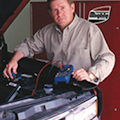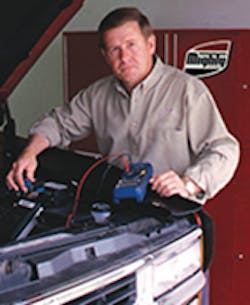The primary objective of thorough inspections and system maintenance is to prevent some unnecessary and costly repair expense for the customer. System neglect can result in hundreds of dollars in repair cost that may have been circumvented by performing some basic maintenance.
Servicing the Brake System Most technicians perform a thorough brake inspection including friction wear and abnormal wear patterns, loose or missing hardware, corrosion and excessively worn or damaged rotors. Unfortunately, few take the time or consideration to flush and restore the lifeblood of the brake system — the brake fluid. Bad things happen to the fluid, and it can occur in a short period of time. Contaminated fluid can result in pedal fade or total brake system failure. In addition to caliper and piston damage from corrosion, costly anti-lock brake system components can be permanently damaged. Brake fluid is hygroscopic and will absorb moisture through the brake hoses, seals and the master cylinder cover. Within a 12 month period, the system can absorb 2 percent of its volume in moisture. A DOT 3 brake fluid with a 3-percent moisture accumulation will experience a 25-percent drop in the boiling point. When this occurs, the system may continue to function normally during normal braking, but one may encounter brake pedal fade during aggressive braking conditions. The DOT 4 brake fluid has a higher boiling point than the DOT 3 fluid, but its wet boiling point may drop more rapidly than the DOT 3 fluid when subjected to moisture. Both the DOT 3 and DOT 4 fluids are comprised of mixtures of glycols and glycol ethers. Additionally, the DOT 4 fluid contains borate esters, which increase the dry and wet boiling points. While both fluids are compatible with the braking systems and internal components, they respond differently when subjected to moisture. Systems filled with DOT 4 fluid will require more frequent flushes. Moisture affects the corrosion inhibitors in the brake fluid, thereby promoting corrosion and failed brake system components. Within 36 months, 91 percent of the corrosion inhibitors in the fluid may be lost. DOT 5 fluid is a silicone fluid, and it is not compatible with other fluids. It is not hygroscopic, therefore, any moisture can pool, promoting corrosion. That can lead to a catastrophic component failure, especially with anti-lock brake system components. Silicone fluid can damage seals because of the lack of additives that lubricate the rubber components. Silicone-based fluids are compressible, causing a soft or spongy pedal sensation. Brake fluid maintenance is imperative.
Major System Contamination Vehicles placed in storage or not driven frequently can encounter major contamination, too. Let’s consider a 1969 Corvette that received a body-off frame restoration, was driven occasionally over a two-year period and then placed in storage for 25 years. The braking system on this vehicle is a four-wheel disc four-piston caliper assembly. The following illustrations reflect what can happen to a braking system, especially when the vehicle encounters long periods of storage with no maintenance/fluid flushes. The pistons were heavily corroded (see Fig.1). The calipers revealed no evidence of fluid; instead they were contaminated with a rusty powdery residue (Fig.2) that had the appearance and texture of sand and gravel. When the vehicle went through the major restoration, DOT 5 silicone brake fluid was installed, which is not recommended. The repair required a total system replacement, which included brake lines, hoses, master cylinder, proportioning valve, calipers, pistons and seals. While this system failure was an extreme example, it illustrates how bad things can happen to the braking system, even when the vehicle is not driven on a daily basis, when brake fluid flushes are not performed. Contamination conditions usually encompass caliper bores that contain a sludge or milky deposit due to the hygroscopic action of the brake fluid. When these conditions occur, brake pedal fade or a total loss of pedal can occur during an aggressive braking condition. Brake fluid flushes are recommended every two years or 24,000 miles. Always refer to the manufacturer’s recommendation for fluid replacement.
Installing the Correct Oil Filter With most vehicle manufacturers offering extended service intervals, nothing is more critical than selecting the correct oil filter and lubricant for the application. Lubricants and filters you have relied on in the past are often not compatible with today’s technology and may result in engine noise or internal component failure. Changes in bearing technology and variable valve timing, which allows continuous camshaft adjustments to advance or retard the timing to control emissions and increase performance and fuel economy, makes filter and lubricant selection critical. Make certain your filter selection is from a trusted source. It is impossible to determine the quality of the filter by the physical dimensions and thread size. The filtration of the media is determined by special equipment and testing procedures. Filter bypass settings are critical, especially with newer engine technology and higher oil pressure differentials across the filter. This requires a filter with a higher bypass setting to prevent unfiltered oil from damaging the bearings and internal engine components. Where applicable, extended life oil filters should be used on vehicles that are serviced at extended oil drain intervals. If not, filter bypass can occur. When this occurs, contaminated oil is flowing through the engine. For vehicles not equipped with a “Maintenance Reminder,” make certain you determine if the customer is operating the vehicle under normal or severe service conditions. Most will be surprised to learn they operate their vehicle under severe conditions. Severe Service: 1) Vehicles driven for short distances of five miles or less, results in the oil not reaching its normal operating temperature, which is necessary to burn off condensation. 2) Vehicles driven 10 miles or less at temperatures below freezing 3) Vehicles that encounter extended periods of idling or slow-speed driving such as police cars, taxis, delivery vehicles or vehicles operated in heavy traffic conditions 4) Vehicles driven in hot ambient temperatures (above 90 degrees F), especially in heavy traffic 5) Dusty conditions 6) Muddy, sandy, salt-spread or rough road conditions 7) Extended driving while exceeding normal highway speeds 8) Frequent starting and stopping
Gasoline Direct Injection The gasoline direct injection (GDI) system injects fuel directly into the combustion chamber at pressures that can exceed 2,000 psi. Unlike a port fuel injection (PFI) system, the GDI system does not spray fuel directly onto the intake valves, resulting in the formation of carbon deposits on the intake valves because of the absence of the fuel wash. Fuel additives placed in the fuel tank offer no benefit to the intake valves on the GDI system. Intake valve contamination occurs because of the following events: The crankcase is purged via a positive crankcase ventilation (PCV) valve, and the vapors are routed through the intake manifold and intake valves where they are consumed in the combustion process. During this purging event, the intake valves are subjected to oil vapors, which get baked onto the valves. Oil seepage past the intake valve guides and seals contribute to the same. High-mileage engines with excessive wear promote a faster accumulation of the deposits. Exhaust gas recirculation (EGR) further aggravates the condition.
Preventive Maintenance Examining an engine for excessive intake valve deposits and the removal of the deposits can be labor intensive, often requiring the removal of the intake manifold and cylinder heads. To prevent the contamination from getting to the level that the valves are totally encrusted and making a clean-up difficult, we recommend an annual intake cleaning. This should be performed once a year or every 15,000 miles to minimize the formation of the carbon deposits. The cleaning process involves introducing chemicals into the intake manifold down-stream of the mass airflow sensor. This treatment can minimize the formation of the carbon deposits. Once heavy deposits accumulate, cleaning can result in large fragments breaking loose, causing piston or cylinder wall damage. A little attention to preventive maintenance can save the customer a lot of unnecessary repair cost.
About the Author

